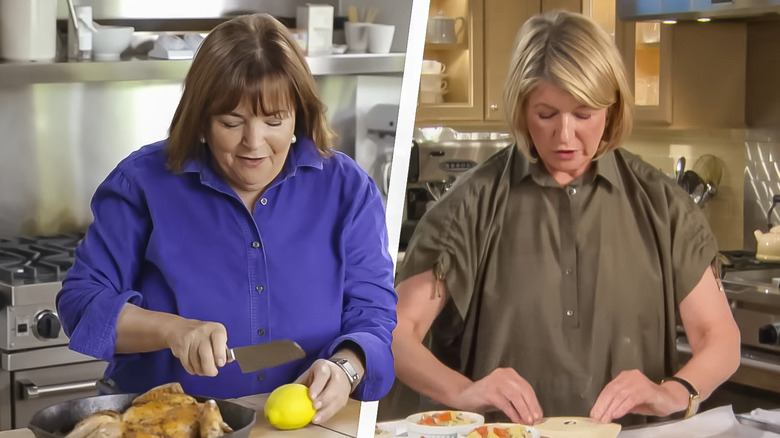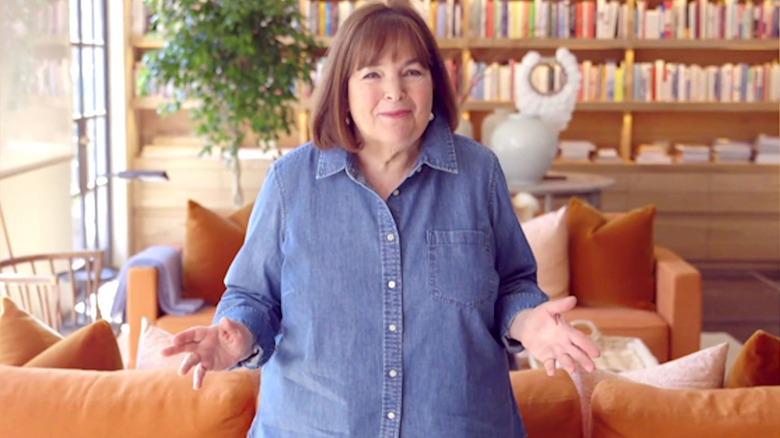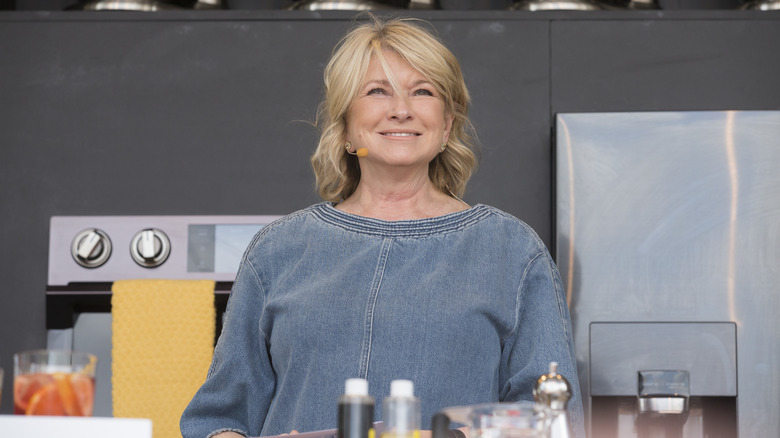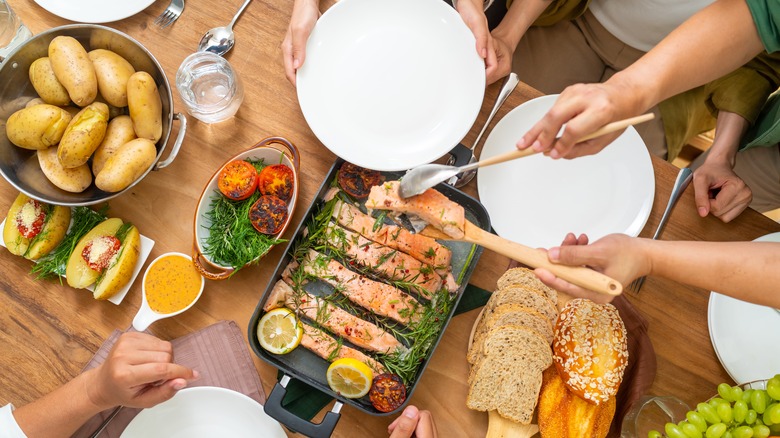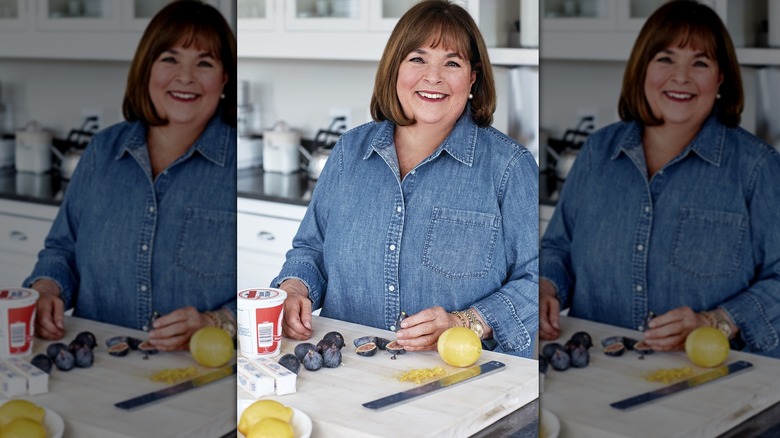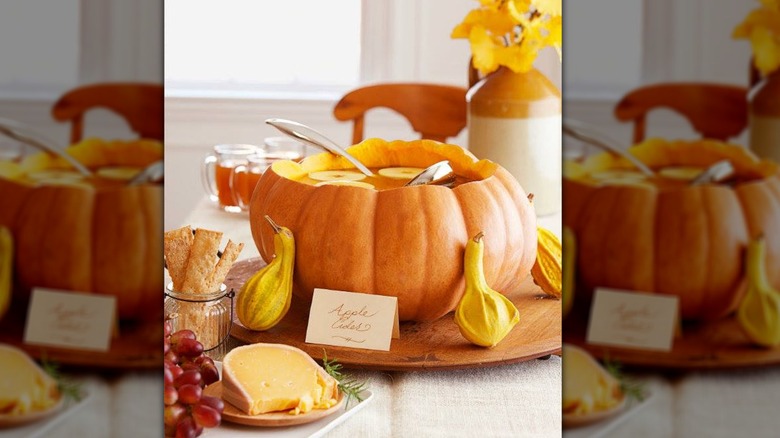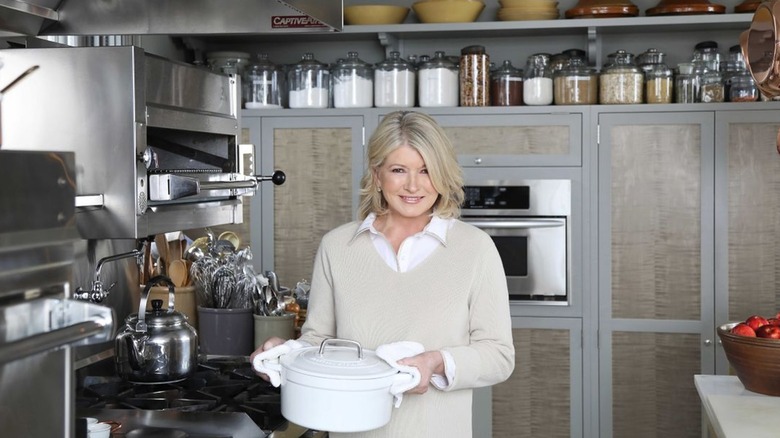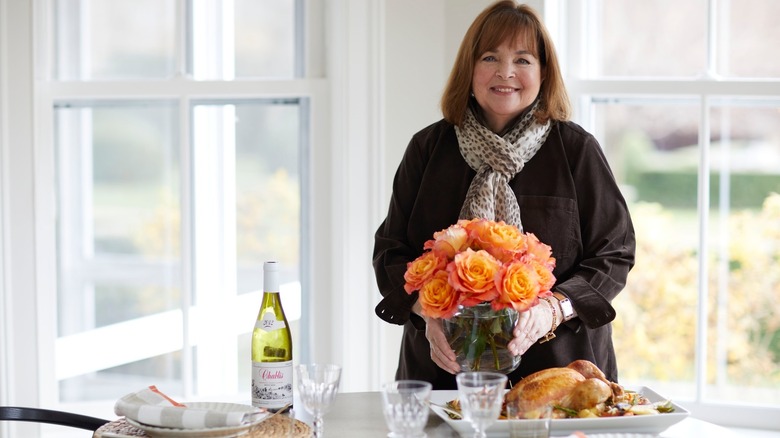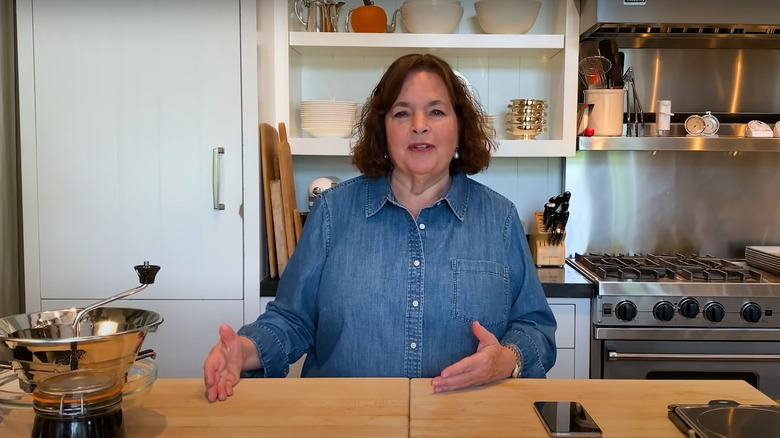Ina Garten's Cooking Style Vs Martha Stewart's: Everything You Need To Know
We may receive a commission on purchases made from links.
A generation of home cooks have grown up learning to make delicious food from the culinary prowess of both Ina Garten and Martha Stewart. Dominating the culinary industry today, the two are often pegged against each other but most people don't know the truth about their friendship, as they have more in common than you think. For starters, both Stewart and Garten were living in the Hamptons at the same time (in the '90s). Garten was working out of her specialty food store, the Barefoot Contessa; Ina told podcast host Michael Ian Black in 2017 that she and Martha became friends when Martha visited her store. Later Martha encouraged Ina to publish her first cookbook, for which she penned the foreword.
In the podcast, Ina also addressed the distinction between her style and Martha's, saying that Stewart took home arts to a whole new level and made it something people became proud to do in a time when it wasn't valued. Ina contributed to the field by taking it in her own direction and making cooking simple and relatively easy for home cooks with no professional experience to dabble in.
Aside from their specific approaches to cooking, Martha and Ina differ on many fronts, such as ingredient selection, recipe complexity, aesthetic preference, and even preferred cuisine choices. Wondering whose culinary path you should follow? We've analyzed their recipes and cooking styles side by side to give you a full comparison according to your skill level.
Ina describes her cooking style as simple and elegant
For the 76-year-old Barefoot Contessa, cooking is still a challenging prospect, which has defined the style she chooses to cook in throughout her career. Ina says that she's not a confident cook, owing to her lack of professional culinary training, so preparing a meal for a party of four remains daunting. Despite her concerns, Garten's success in the kitchen is no secret to the world. She has won the highest culinary accolade — a James Beard Award – and four Emmy awards for her cooking show "Barefoot Contessa."
Ina says her husband and longtime guest on her cooking show explains why she never steps down from pursuing her passion: "Jeffrey says if it wasn't hard, I wouldn't think it was interesting," she told Vanity Fair. "So that part of it, I like. I like the challenge of it." Moreover, in an interview with the New York Times, Garten explains that her cooking style can be described as "simple and elegant," which allows her to build on the essential flavors of dishes to transform them into something delicious. Garten's signature meal – either a roast chicken or a rack of lamb with orzo, with her French apple tart for dessert — definitely reflects this philosophy. Garten's cooking illustrates the proverb "There is beauty in simplicity." You can see this reflected in her cooking techniques, which have made a generation of home cooks more confident in the kitchen.
Ina uses simple and high-quality ingredients in her cooking
For Ina Garten, simplicity takes center stage, whether it's in her recipes or ingredient selection. Ina uses easily available ingredients in her cooking, defined down to the exact brand, and recommends her followers to do the same. She believes that simple ingredients that are high-quality, such as Dutch processed cocoa powder, can really elevate the dish and bring out the flavor. In her famous Beatty's chocolate cake recipe, she recommends using ”good cocoa powder” for the batter such as Pernigotti or Valrhona , and fine quality chocolate like Callebaut or Valrhona in the frosting.
Her belief extends to the elements she uses in her recipes as well. Garten tells Food & Wine she doesn't bother making complicated elements like Bouillabaisse or a demi-glace in her recipes, as they require too much time and expertise, and the final product is consumed far more quickly than the time it took to prepare. She instead recommends using fresh seasonal ingredients which are generally less expensive and taste much better than alternatives. In the same interview, she says, ”In the spring, when asparagus is coming in, all you have to do is roast it on a sheet pan with olive oil, salt, and pepper, put it in the oven, and maybe in the last 60 seconds add some Parmesan, and you've got a fabulous side dish.” With Ina's approach, cooks of all levels can master making simple meals with ease.
Martha uses varying exotic ingredients and expert cooking techniques
Martha Stewart's cooking is just what you would expect it to be — expert techniques that maximize efficiency. Martha's penchant for flair is what makes her come up with new and more creative cooking methods, whether it's her approach to use the steam wand on her espresso machine to make scrambled eggs, or using homemade clarified butter to cook eggs in for a depth of flavor. Her techniques allow home cooks to think outside the box and use every ingredient and device in the kitchen to their advantage, which is great if you want to become more comfortable cooking.
Martha constantly wants cooks to experiment with flavors and techniques that will make their food stand out, such as using bechamel sauce to make macaroni and cheese, deglazing a roasting pan with red wine while making beef stock, and cooking lobster in vodka. Her approach to ingredients is similar, whereby she prefers to use farm-grown eggs laid by her chickens in everyday cooking, and only picks out the highest quality cheese (Grana Padano), chickens, and produce to cook for her upscale Bradford restaurant (via Tasting Table). Martha's cooking style is for every aspiring chef to dabble in, as she helps everyone from the timid novice to the expert home cook with her life-saving kitchen hacks and innovative recipes.
Stewart dabbles in global cuisines while Garten focuses on simple American fare
If you're a fan of Ina Garten's cooking or have come across her show "Barefoot Contessa" on the Food Network, you'll see her mostly prepping a classic American recipe or a French dish, be it pie, a pot roast, a tea cake, or a sandwich. That's because Garten tends to stick to food that her audience is already familiar with while adding her touch of elevated home cookery. This is due to Garten's background in catering, where she prepared deliciously simple meals for her Hampton's specialty food store, which had customers hooked to her chicken salads, scones, and baguettes, among other scrumptious fare.
On the other hand, Martha Stewart has kept her fingers in every pot, dabbling in global cuisines whenever she can and delivering excellent recipes for the curious cook to try. Martha tends to concentrate on American, Asian, French, and Italian fare, whether it's her famous one-pan pasta, a spicy pot of slow-cooker Tom Kha Gai, Italian-braised pork, or a Persian lamb stew — Martha's version of these beloved recipes is testament to her expertise and comfort in working with multiple cuisines. When asked where she gets the inspiration for her dishes, she credits her travels, particularly those to Russia, which make her feel close to her Polish heritage. There Martha was served baked potatoes loaded with caviar that later became the inspiration for a similar dish on her restaurant's menu.
Garten's recipes are uncomplicated and straightforward while Martha's are more detailed and meticulous
An Ina Garten recipe can be prepared in advance, comes together in an hour, and involves easy-to-follow instructions. They can turn an inexperienced cook into a pro: Trent Pheifer told "Today" making all 1,272 of Ina Garten's recipes helped him become more educated and confident. It's no surprise Ina's carefree manner and genuineness in the kitchen have become the reason many people have fallen in love with cooking and swear by her recipes today. In an interview with "60 Minutes," Ina told viewers she makes her recipes 10 to 25 times to nail the exact measurements and instructions, then her assistants make them. Her ideology is that following a recipe should make people feel like she's standing right next to them, guiding their hands as they cook.
A classic Martha recipe, on the other hand, is one meant to exact perfection since it offers meticulous detail and is usually for more experienced cooks. Although Martha has her fair share of cooking hacks to help beginners make their way around the kitchen easily, she generally opts for an expert approach. Take her turkey recipe for example, which uses a spatchcock technique to reduce cooking time and make the process easy, while requiring snipping out the backbone, cracking the chest bone, and butterflying the entire turkey. Not beginner-friendly, but efficient nonetheless; it has your turkey done in 75 minutes, tasting like a Thanksgiving meal sent from heaven.
Garten's recipes use precise techniques while Stewart's leave room for improv
The internet's favorite activity is making Martha and Ina's recipes side by side to determine recipe complexity, ingredient differences, and preferred cooking methods. Take the two culinary queens' BLT recipes to start: Ina makes an exact recipe using baked bacon strips, avocado, tomato, lettuce, and "good mayo," while Martha's requires making homemade mayonnaise, plus using thick-cut bacon and fresh basil in addition to tomatoes and lettuce. Although both recipes are delicious, it's easy to see which version can make a meal gourmet and which one can make you crave the BLT you grew up with.
Another favorite recipe comparison is between their adult grilled cheese sandwiches. Ina's version is called the Ultimate Grilled Cheese, which specifies brands for the ingredients (such as Cabot sharp cheddar cheese), plus gruyère, bacon strips, and a cheesy mustard spread. Whereas Martha's tendency to improvise as you go divides her Grown-Up Grilled Cheese recipe into multiple versions which can be made with any combination of ingredients like bacon, oil-packed sardines, red onion, avocado, jalapeño, Peppadew peppers, or pears, according to your palate. This lends her recipe a complexity of flavors previously not associated with grilled cheese and pairs it with a sweet touch from optional fruit preserves like fig jam. To sum up, whether you make Martha's take on a recipe or Ina's, you're sure to end up with an indulgent dish that's pleasing.
Presentation takes center stage for Martha while Ina focuses on a rustic aesthetic
The Ina Garten charm lies in her approachability to the average home cook, as in episodes of her cooking show, she cooks for her loving partner, pretends to get tipsy with her bridge buddies, and she even looks like she could be your grandmother! That's all due to Ina's focus on a homely aesthetic that looks easily replicable, especially in her no-fuss recipes that favor flavor over presentation. The only simple tips Ina presents to keep your space attractive for yourself and guests are making plenty of floral arrangements, separating your china and old silver for display purposes, and organizing fruits into bowls for easy kitchen decor.
In contrast, Martha's whole aesthetic is rooted in pristine tablescapes and picture-perfect dishes, like tips for table setting for casual and formal dining that she's shared on her blog. Martha's flair for fancy also had her set up a deconstructed charcuterie board for her guests which resembled a cheese buffet, featuring each cheese, dip, and side placed on raised cake stand-like pedestals. Ina elaborates on their different approaches to cooking and presentation by saying in People, "I think maybe what I do is I take one step back and make it a little simpler so it's really doable. Martha does love the gorgeous presentation, so if she's making a pumpkin soup, she might carve out a pumpkin and serve it in the pumpkin, which is great."
Martha appeals to the experienced cook who wants to elevate their cooking skills
Now that we've addressed some major points that make these cooking queens distinct, let's focus on which one you should follow according to your skill level. If you have the basics down after cooking for a few years and want to upgrade your skills, Martha's the chef for you. Her recipes help you perfect classics like chocolate chip cookies and mac and cheese, experiment with dishes like basic pierogi, and even delve into the art of slow cooking. Her cookbook "Martha Stewart's Slow Cooker" is a great place to start trying out her recipes without being too hands-on, and appreciating the indulgent flavor slow cooking brings to meats and sweets.
Martha also lends her expert advice every step of the way to streamline cooking. She recommends practicing the art of mise en place while cooking (measuring out the exact ingredients before you start), cooking in batches (and freezing the rest for later), and pairing the right wine with your food to maximize its taste. Finally, if you want to cook like Martha Stewart and know what she really eats, start by nailing the recipes she thinks everyone should learn how to make (via Business Insider), including apple pie, lemon meringue pie, her mother's pierogies, her simple salad vinaigrette, and her morning green juice.
Ina focuses on the home cook who needs a day-to-day savior in the kitchen
Even the most professional chefs have needed a savior in the kitchen from time to time, and who better to save you from the roller coaster ride that is cooking than the Barefoot Contessa herself? Following Ina's recipes and her tips to optimize the cooking process will relieve every home cook from the burden of planning daily meals and hosting parties. Ina instructs home cooks to prepare meals they're comfortable cooking and have made before, especially when having guests over, and not trying out something new that can go awry at the last minute. She also suggests making the best use of time by prepping your food the day before, like baking cupcakes in advance, and only finishing stuff last minute to save yourself an exhausting day of cooking and hosting.
Adding to the ease of home cooking, most of Ina's recipes have elements you can make ahead (or even the entire dish). Her cookbook "Make It Ahead" is a culmination of recipes you can prep beforehand, ideal for those with busy schedules. Although it won't be a piece of cake to follow all of Ina's recipes and have them turn out perfectly each time, you'll have a terrific road map to follow — which will give you the chance to transform and hone your cooking abilities over time.
Both culinary queens swear against using certain ingredients
Despite their many differences, both Ina Garten and Martha Stewart steer clear of certain ingredients in their recipes and in their food preferences. For Ina Garten, it's the controversial herb cilantro, which the chef claims she can't stand. With more than 1,000 recipes in her cookbooks and on her TV show, this is the one ingredient you'll never find in the Barefoot Contessa's dishes. Garten says that although people can add it to whichever dish they like, she hates it and finds it tastes like soap, which overpowers every other flavor in the meal for her. Ina isn't alone in her dislike, as a study by Cornell University found that a genetic variation influences the taste of cilantro for people.
However, for Martha Stewart, it's more than just one food she can't stand. The lifestyle guru shared that she would never consume truffle oil or use it in her recipes as it's a synthetic oil that contains no real truffles, having studies done that show the oil's harm. Although Martha has a point with her hate for truffle oil, her other aversions aren't as easily avoidable. Martha says she would never make a salad with grilled chicken, opting for a fresh vegetable and seafood version instead, as grilled chicken isn't her style. Moreover, in an interview with Anthony Bourdain, Martha dissed pumpkin spice, agreeing it is a seasoning for basic b****** — but that's enough shockers for today!
Ina stresses using basic cooking equipment for everyday usage
Even though we can't all have the East Hamptons lifestyle and apple orchard views Ina Garten wakes up to, we can make our kitchen counters and pantries look a little bit more like hers with a few simple tools. Ina says she uses basic equipment for her everyday cooking, such as an ice cream scoop to make evenly-sized muffins and meatballs, bowls of room-temperature eggs and fruits on her counter, and a jar of spoons she can reach easily while cooking and taste testing. Some instruments she recommends home cooks to invest in which are cheap and make sticking to a recipe much easier include a digital scale for exact measurements, an oven thermometer to cook your food at the recommended temperatures, and an oven timer.
Ina also says a few pieces of good equipment – like sharp kitchen knives — are much more efficient for cooking than a hundred dull specialty knives.
Static Media owns and operates Mashed and Tasting Table.
